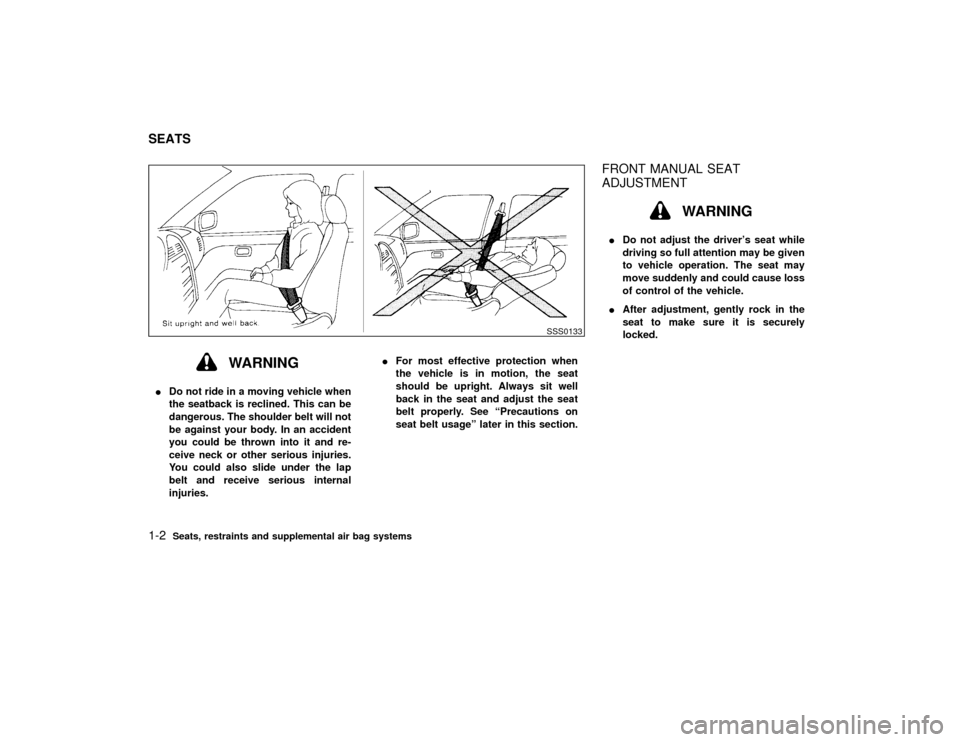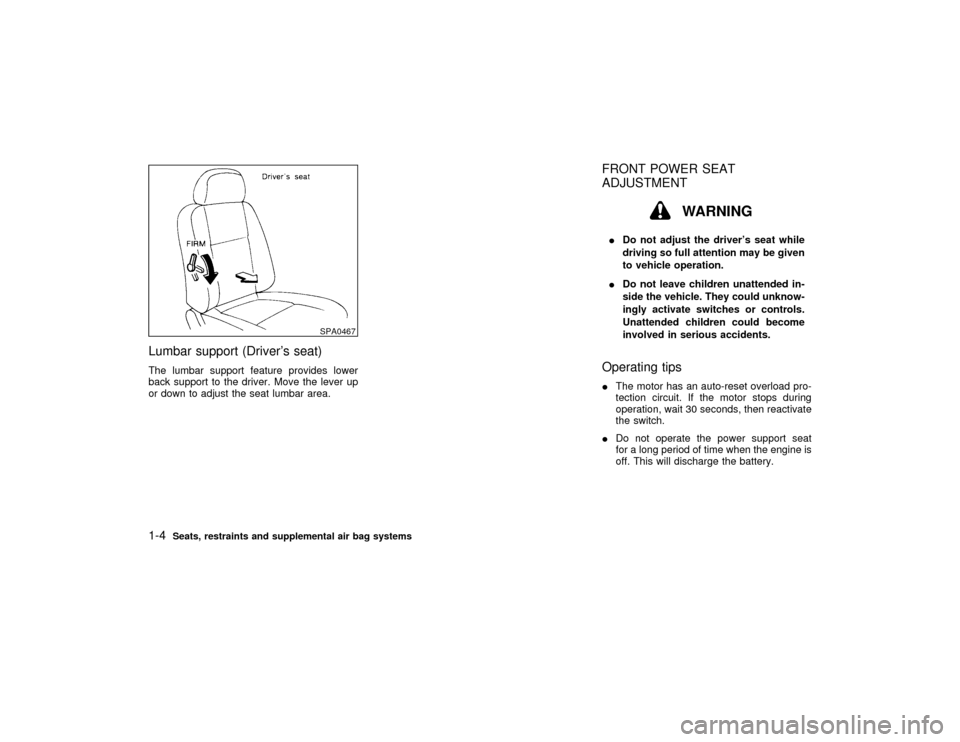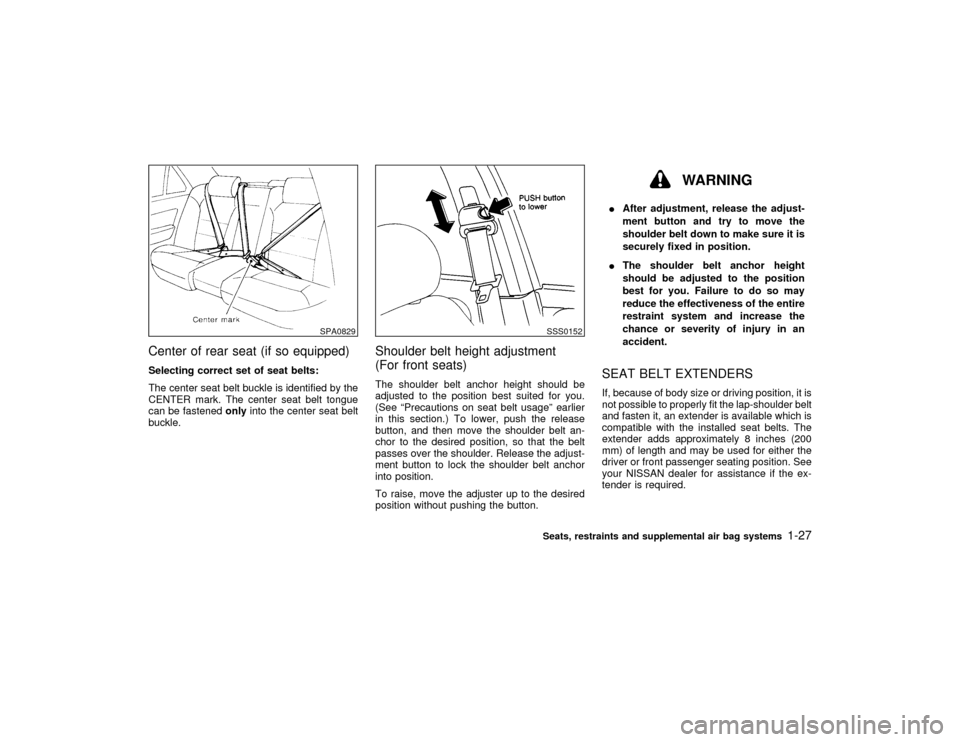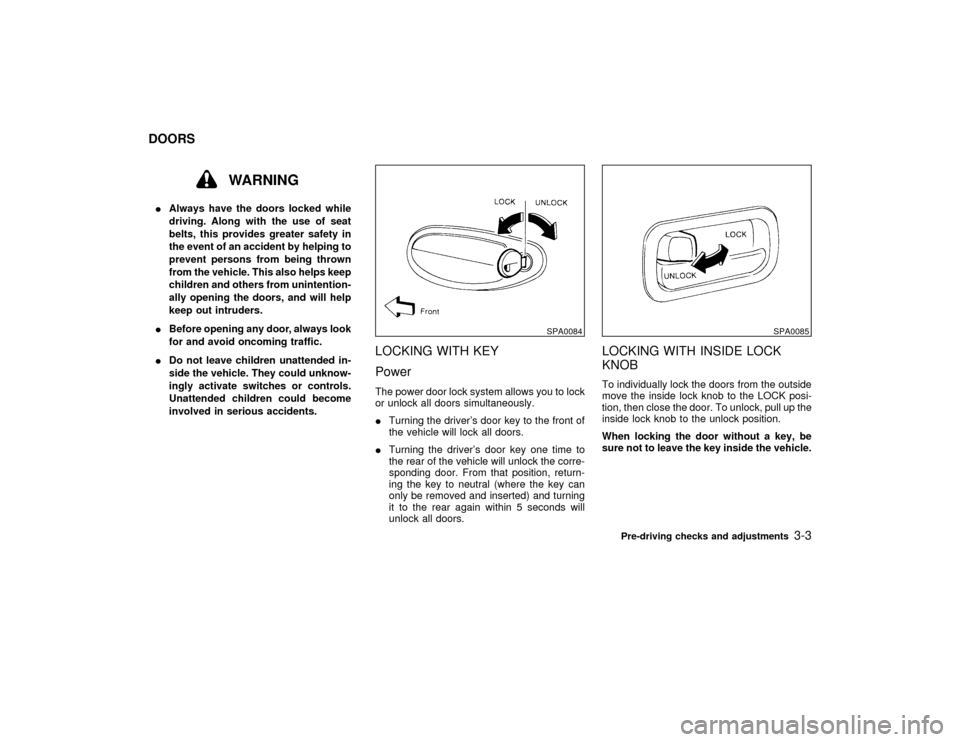2001 NISSAN MAXIMA seat adjustment
[x] Cancel search: seat adjustmentPage 5 of 247

Table of
Contents
Seats, restraints and supplemental air bag systemsInstruments and controlsPre-driving checks and adjustmentsHeater, air conditioner and audio systemsStarting and drivingIn case of emergencyAppearance and careDo-it-yourselfMaintenanceTechnical and consumer informationIndex
Z
00.1.17/A33-D/V5.0
X
Page 6 of 247

1 Seats, restraints and supplemental air bag
systemsSeats ......................................................................... 1-2
Front manual seat adjustment ............................. 1-2
Front power seat adjustment ............................... 1-4
Folding rear seat ................................................. 1-6
Head restraint adjustment .................................... 1-7
Active head restraint (front seats) ........................ 1-8
Armrest ................................................................. 1-9
Supplemental restraint system .................................. 1-9
Precautions on supplemental restraint system .... 1-9
Supplemental air bag warning labels ................. 1-19
Supplemental air bag warning light .................... 1-19
Seat belts ................................................................ 1-21
Precautions on seat belt usage ......................... 1-21
Child safety......................................................... 1-23Pregnant women ................................................ 1-24
Injured persons................................................... 1-24
Three-point type seat belt with retractor ............ 1-24
Seat belt extenders ............................................ 1-27
Seat belt maintenance ....................................... 1-28
Child restraints ........................................................ 1-28
Precautions on child restraints ........................... 1-28
Installation on rear seat outboard or center
positions ............................................................. 1-30
LATCH (Lower anchors and tether for children)
system ................................................................ 1-35
Top tether strap child restraint ........................... 1-36
Installation on front passenger seat ................... 1-37
Z
00.1.17/A33-D/V5.0
X
Page 7 of 247

WARNING
IDo not ride in a moving vehicle when
the seatback is reclined. This can be
dangerous. The shoulder belt will not
be against your body. In an accident
you could be thrown into it and re-
ceive neck or other serious injuries.
You could also slide under the lap
belt and receive serious internal
injuries.IFor most effective protection when
the vehicle is in motion, the seat
should be upright. Always sit well
back in the seat and adjust the seat
belt properly. See ªPrecautions on
seat belt usageº later in this section.
FRONT MANUAL SEAT
ADJUSTMENT
WARNING
IDo not adjust the driver's seat while
driving so full attention may be given
to vehicle operation. The seat may
move suddenly and could cause loss
of control of the vehicle.
IAfter adjustment, gently rock in the
seat to make sure it is securely
locked.
SSS0133
SEATS1-2
Seats, restraints and supplemental air bag systems
Z
00.1.17/A33-D/V5.0
X
Page 9 of 247

Lumbar support (Driver's seat)The lumbar support feature provides lower
back support to the driver. Move the lever up
or down to adjust the seat lumbar area.
FRONT POWER SEAT
ADJUSTMENT
WARNING
IDo not adjust the driver's seat while
driving so full attention may be given
to vehicle operation.
IDo not leave children unattended in-
side the vehicle. They could unknow-
ingly activate switches or controls.
Unattended children could become
involved in serious accidents.Operating tipsIThe motor has an auto-reset overload pro-
tection circuit. If the motor stops during
operation, wait 30 seconds, then reactivate
the switch.
IDo not operate the power support seat
for a long period of time when the engine is
off. This will discharge the battery.
SPA0467
1-4
Seats, restraints and supplemental air bag systems
Z
00.1.17/A33-D/V5.0
X
Page 12 of 247

IClosely supervise children when they
are around cars to prevent them from
playing and becoming locked in the
trunk where they could be seriously
injured. Keep the car locked with the
rear seatback securely latched when
not in use, and prevent children's
access to car keys.
HEAD RESTRAINT ADJUSTMENTTo raise the head restraint, just pull it up. To
lower, push the lock knob and push the head
restraint down.
WARNING
Head restraints should be adjusted
properly as they may provide significant
protection against injury in an accident.
Do not remove them. Check the adjust-ment after someone else uses the seat.
SSS0125Seats, restraints and supplemental air bag systems
1-7
Z
00.1.17/A33-D/V5.0
X
Page 32 of 247

Center of rear seat (if so equipped)Selecting correct set of seat belts:
The center seat belt buckle is identified by the
CENTER mark. The center seat belt tongue
can be fastenedonlyinto the center seat belt
buckle.
Shoulder belt height adjustment
(For front seats)The shoulder belt anchor height should be
adjusted to the position best suited for you.
(See ªPrecautions on seat belt usageº earlier
in this section.) To lower, push the release
button, and then move the shoulder belt an-
chor to the desired position, so that the belt
passes over the shoulder. Release the adjust-
ment button to lock the shoulder belt anchor
into position.
To raise, move the adjuster up to the desired
position without pushing the button.
WARNING
IAfter adjustment, release the adjust-
ment button and try to move the
shoulder belt down to make sure it is
securely fixed in position.
IThe shoulder belt anchor height
should be adjusted to the position
best for you. Failure to do so may
reduce the effectiveness of the entire
restraint system and increase the
chance or severity of injury in an
accident.SEAT BELT EXTENDERSIf, because of body size or driving position, it is
not possible to properly fit the lap-shoulder belt
and fasten it, an extender is available which is
compatible with the installed seat belts. The
extender adds approximately 8 inches (200
mm) of length and may be used for either the
driver or front passenger seating position. See
your NISSAN dealer for assistance if the ex-
tender is required.
SPA0829
SSS0152Seats, restraints and supplemental air bag systems
1-27
Z
00.1.17/A33-D/V5.0
X
Page 34 of 247

INISSAN recommends that the child
restraint be installed in the rear seat.
According to accident statistics, chil-
dren are safer when properly re-
strained in the rear seat than in the
front seat.
IAn improperly installed child re-
straint could lead to serious injury or
death in an accident.
In general, child restraints are designed to be
installed with the lap portion of a three-point
type seat belt. In addition, this vehicle is
equipped with a universal child restraint lower
anchor system, referred to as the LATCH
(Lower Anchors and Tether for Children) sys-
tem. Some child restraints include two rigid or
webbing-mounted attachments that can be
connected to these lower anchors. For details,
see ªLATCH (Lower Anchors and Tether for
Children) SYSTEMº later in this section.
Child restraints for infants and children of
various sizes are offered by several manufac-
turers. When selecting any child restraint,
keep the following points in mind:
Ichoose only a restraint with a label certify-
ing that it complies with Federal MotorVehicle Safety Standard 213 or Canadian
Motor Vehicle Safety Standard 213.
Icheck the child restraint in your vehicle to
be sure it is compatible with the vehicle's
seat and seat belt system. Choose a child
restraint that meets the guidelines of the
Society of Automotive Engineers recom-
mended practice J1819 for child restraint
installation.
Iif the child restraint is compatible with your
vehicle, place your child in the child re-
straint and check the various adjustments
to be sure the child restraint is compatible
with your child. Always follow all recom-
mended procedures.
All US states and Canadian provinces re-
quire that infants and small children be
restrained in approved child restraints at
all times while the vehicle is being oper-
ated.
WARNING
IImproper use of a child restraint can
result in increased injuries for both
the infant or child and other occu-
pants in the vehicle.IFollow all of the child restraint manu-
facturer's instructions for installation
and use. When purchasing a child
restraint, be sure to select one which
will fit your child and vehicle. It may
not be possible to properly install
some types of child restraints in your
vehicle.
IIf the child restraint is not anchored
properly, the risk of a child being
injured in a collision or a sudden stop
greatly increases.
IAdjustable seatbacks should be posi-
tioned to fit the child restraint, but as
upright as possible.
IAfter attaching the child restraint,
test it before you place the child in it.
Tilt it from side to side. Try to tug it
forward and check to see if the belt
holds the restraint in place. If the
restraint is not secure, tighten the
belt as necessary, or put the restraint
in another seat and test it again.
IFor a front facing child restraint,
check to make sure the shoulder belt
Seats, restraints and supplemental air bag systems
1-29
Z
00.1.17/A33-D/V5.0
X
Page 88 of 247

WARNING
IAlways have the doors locked while
driving. Along with the use of seat
belts, this provides greater safety in
the event of an accident by helping to
prevent persons from being thrown
from the vehicle. This also helps keep
children and others from unintention-
ally opening the doors, and will help
keep out intruders.
IBefore opening any door, always look
for and avoid oncoming traffic.
IDo not leave children unattended in-
side the vehicle. They could unknow-
ingly activate switches or controls.
Unattended children could become
involved in serious accidents.
LOCKING WITH KEY
PowerThe power door lock system allows you to lock
or unlock all doors simultaneously.
ITurning the driver's door key to the front of
the vehicle will lock all doors.
ITurning the driver's door key one time to
the rear of the vehicle will unlock the corre-
sponding door. From that position, return-
ing the key to neutral (where the key can
only be removed and inserted) and turning
it to the rear again within 5 seconds will
unlock all doors.
LOCKING WITH INSIDE LOCK
KNOBTo individually lock the doors from the outside
move the inside lock knob to the LOCK posi-
tion, then close the door. To unlock, pull up the
inside lock knob to the unlock position.
When locking the door without a key, be
sure not to leave the key inside the vehicle.
SPA0084
SPA0085
DOORS
Pre-driving checks and adjustments
3-3
Z
00.1.17/A33-D/V5.0
X